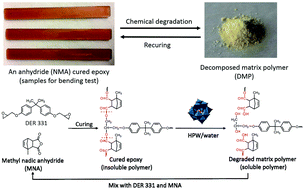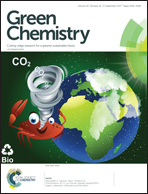Selective cleavage of ester linkages of anhydride-cured epoxy using a benign method and reuse of the decomposed polymer in new epoxy preparation†
Abstract
Thermosetting polymers possess high dimensional stability, chemical resistance and thermal stability, and they are indispensable for many applications. However, conventional thermosetting polymers cannot be reprocessed and reshaped due to their permanent cross-linked structure. Therefore, recycling of thermosetting polymers is a serious challenge. Degrading thermosetting polymers into soluble oligomers and reuse of the oligomers in new resin systems may provide a favorable way to solve this problem. In this work, we developed an efficient method for chemical degradation of anhydride-cured epoxy using environmentally benign phosphotungstic acid (HPW) aqueous solution as the catalyst system at a mild reaction temperature of 190 °C. During reaction, the ester bond in the cross-linked structure was selectively cleaved, and the thermosetting polymer was fully converted to oligomers that contain multifunctional reactive groups. When the decomposed matrix polymer (DMP) was used as a reactive ingredient and added up to 40 wt% in the preparation of a new anhydride-cured epoxy curing system, the resulting cross-linked polymers still retained the mechanical properties of the neat polymer.



 Please wait while we load your content...
Please wait while we load your content...